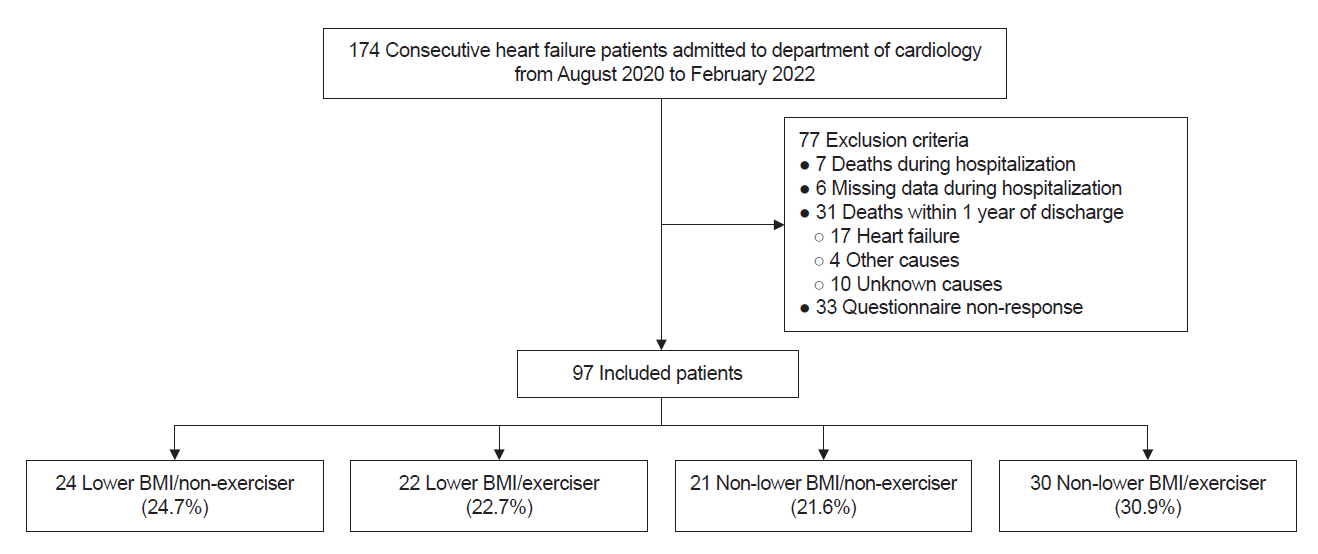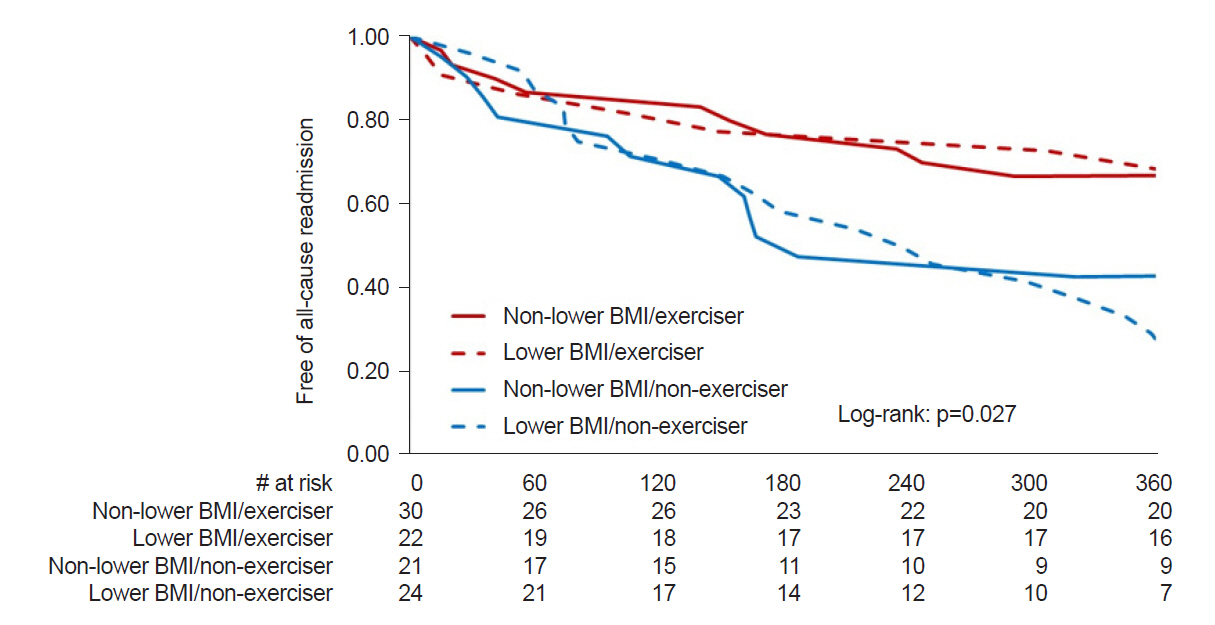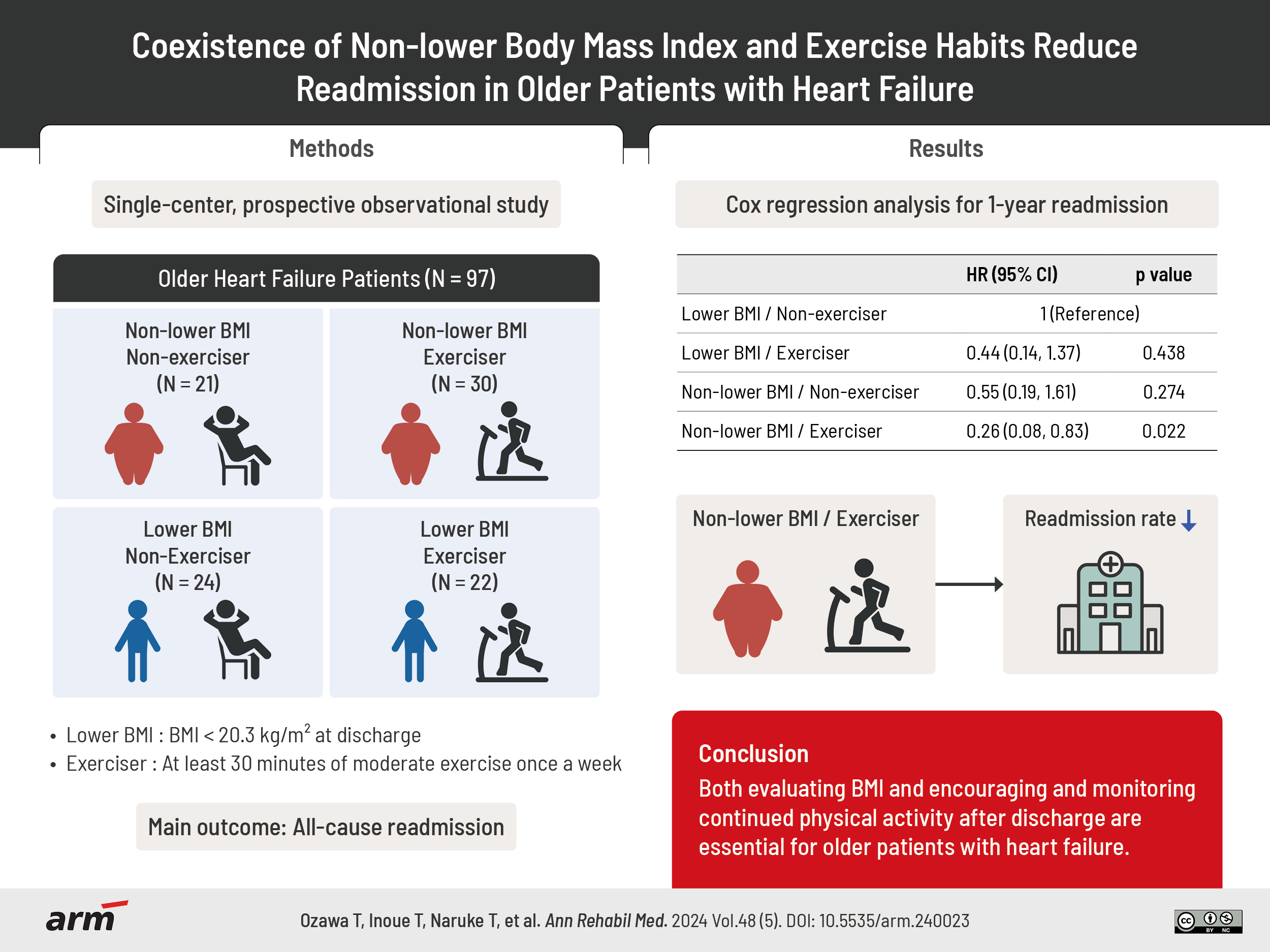Ann Rehabil Med.
2024 Oct;48(5):344-351. 10.5535/arm.240023.
Coexistence of Non-Lower Body Mass Index and Exercise Habits Reduce Readmission in Older Patients With Heart Failure
- Affiliations
-
- 1Department of Rehabilitation, Odawara Municipal Hospital, Odawara, Japan
- 2Department of Physical Therapy, Niigata University of Health and Welfare, Niigata, Japan
- 3Department of Cardiovascular Medicine, Odawara Municipal Hospital, Odawara, Japan
- 4Department of Rehabilitation Medicine, Tokai University School of Medicine, Isehara, Japan
- KMID: 2560472
- DOI: http://doi.org/10.5535/arm.240023
Abstract
Objective
To investigate the impact of body mass index (BMI) and exercise habits on readmission rates among older patients with heart failure.
Methods
Ninety-seven older patients admitted for heart failure (median age: 81 years; 57.7% male) were included in the study. Patients were categorized into four groups based on the presence or absence of lower BMI and/or the absence of exercise habits. Lower BMI was defined as BMI<20.3 kg/m2 at discharge and exercise habits were defined as engaging in 30 or more minutes of moderate or vigorous exercise at least once a week. The primary outcome was all-cause readmission during the 1-year follow-up period.
Results
The patients were distributed across four groups: lower BMI/non-exerciser (n=24, 24.7%), lower BMI/exerciser (n=22, 22.7%), non-lower BMI/non-exerciser (n=21, 21.6%), and non-lower BMI/exerciser (n=30, 30.9%). Forty-six patients (47.4%) experienced readmission during the 1-year follow-up period. In a cox proportional hazard analysis, non-lower BMI/exerciser remained an independent prognostic factor even after adjusting for confounding factors (non-lower BMI/exerciser vs. lower BMI/non-exerciser: hazard ratio, 0.26; 95% confidence interval, 0.08–0.83; p=0.022).
Conclusion
The coexistence of non-lower BMI and regular exercise habits may reduce readmission during the 1-year in older patients with heart failure. Therefore, it is imperative to conduct appropriate nutritional assessments for patients with lower BMI at discharge. Additionally, promoting and monitoring sustained physical activity after discharge is crucial for older patients with heart failure.
Figure
Reference
-
1. Okura Y, Ramadan MM, Ohno Y, Mitsuma W, Tanaka K, Ito M, et al. Impending epidemic: future projection of heart failure in Japan to the year 2055. Circ J. 2008; 72:489–91.
Article2. Shiraishi Y, Kohsaka S, Sato N, Takano T, Kitai T, Yoshikawa T, et al. 9-year trend in the management of acute heart failure in Japan: a report from the National Consortium of Acute Heart Failure Registries. J Am Heart Assoc. 2018; 7:e008687.
Article3. Tsuchihashi M, Tsutsui H, Kodama K, Kasagi F, Setoguchi S, Mohr M, et al. Medical and socioenvironmental predictors of hospital readmission in patients with congestive heart failure. Am Heart J. 2001; 142:E7.
Article4. Bozkurt B, Savarese G, Adamsson Eryd S, Bodegård J, Cleland JGF, Khordoc C, et al. Mortality, outcomes, costs, and use of medicines following a first heart failure hospitalization: EVOLUTION HF. JACC Heart Fail. 2023; 11:1320–32.5. Komukai K, Minai K, Arase S, Ogawa T, Nakane T, Nagoshi T, et al. Impact of body mass index on clinical outcome in patients hospitalized with congestive heart failure. Circ J. 2012; 76:145–51.
Article6. Keteyian SJ, Leifer ES, Houston-Miller N, Kraus WE, Brawner CA, O'Connor CM, et al; HF-ACTION Investigators. Relation between volume of exercise and clinical outcomes in patients with heart failure. J Am Coll Cardiol. 2012; 60:1899–905.
Article7. Hamaguchi S, Tsuchihashi-Makaya M, Kinugawa S, Goto D, Yokota T, Goto K, JCARE-CARD Investigators, et al. Body mass index is an independent predictor of long-term outcomes in patients hospitalized with heart failure in Japan. Circ J. 2010; 74:2605–11.
Article8. Ahn HJ, Lee SR, Choi EK, Han KD, Jung JH, Lim JH, et al. Association between exercise habits and stroke, heart failure, and mortality in Korean patients with incident atrial fibrillation: a nationwide population-based cohort study. PLoS Med. 2021; 18:e1003659.
Article9. Bouillanne O, Morineau G, Dupont C, Coulombel I, Vincent JP, Nicolis I, et al. Geriatric nutritional risk index: a new index for evaluating at-risk elderly medical patients. Am J Clin Nutr. 2005; 82:777–83.
Article10. Pocock SJ, Ariti CA, McMurray JJ, Maggioni A, Køber L, Squire IB, Meta-Analysis Global Group in Chronic Heart Failure, et al. Predicting survival in heart failure: a risk score based on 39 372 patients from 30 studies. Eur Heart J. 2013; 34:1404–13.
Article11. Hamano T, Nagata M, Matsubara R, Ikebata Y, Ito T, Ibe A, et al. Effectiveness of a self-reporting yes/no survey for dementia screening-trial in Fukui, Japan. Front Aging Neurosci. 2023; 14:1029614.
Article12. Tomata Y, Sugiyama K, Kaiho Y, Sugawara Y, Hozawa A, Tsuji I. Predictive ability of a simple subjective memory complaints scale for incident dementia: evaluation of Japan’s national checklist, the “Kihon Checklist”. Geriatr Gerontol Int. 2017; 17:1300–5.
Article13. Aizawa H, Imai S, Fushimi K. Factors associated with 30-day readmission of patients with heart failure from a Japanese administrative database. BMC Cardiovasc Disord. 2015; 15:134.
Article14. Izawa KP, Watanabe S, Oka K, Hiraki K, Morio Y, Kasahara Y, et al. Physical activity in relation to exercise capacity in chronic heart failure patients. Int J Cardiol. 2011; 152:152–3.
Article15. Zhuang B, Shen T, Li D, Jiang Y, Li G, Luo Q, et al. A model for the prediction of mortality and hospitalization in Chinese heart failure patients. Front Cardiovasc Med. 2021; 8:761605.
Article16. Levine B, Kalman J, Mayer L, Fillit HM, Packer M. Elevated circulating levels of tumor necrosis factor in severe chronic heart failure. N Engl J Med. 1990; 323:236–41.
Article17. Rauchhaus M, Doehner W, Francis DP, Davos C, Kemp M, Liebenthal C, et al. Plasma cytokine parameters and mortality in patients with chronic heart failure. Circulation. 2000; 102:3060–7.
Article18. Langhans W, Hrupka B. Interleukins and tumor necrosis factor as inhibitors of food intake. Neuropeptides. 1999; 33:415–24.
Article19. Fathi R, Bacchetti P, Haan MN, Houston TK, Patel K, Ritchie CS. Life-space assessment predicts hospital readmission in home-limited adults. J Am Geriatr Soc. 2017; 65:1004–11.
Article20. Heydari A, Ziaee ES, Gazrani A. Relationship between awareness of disease and adherence to therapeutic regimen among cardiac patients. Int J Community Based Nurs Midwifery. 2015; 3:23–30.21. van der Wal MH, Jaarsma T, Moser DK, Veeger NJ, van Gilst WH, van Veldhuisen DJ. Compliance in heart failure patients: the importance of knowledge and beliefs. Eur Heart J. 2006; 27:434–40.
Article22. Al-Tamimi MA, Gillani SW, Abd Alhakam ME, Sam KG. Factors associated with hospital readmission of heart failure patients. Front Pharmacol. 2021; 12:732760.
Article
- Full Text Links
- Actions
-
Cited
- CITED
-
- Close
- Share
- Similar articles
-
- The Relationship between Stress and Health Habits in Industrial Workers
- A Study of the food Habits of College Students by Body Mass Index
- Skeletal Muscle Mass in Elderly Heart Failure Patients; Comparison between Systolic and Diastolic Heart Failure and Corresponding Significance in Exercise Capacity
- The Effects of Aerobic/Resistance Exercise on Body Fat Mass, Muscle Strength and Endothelial Function in Korean Type 2 Diabetes mellitus Patients
- Cardiac Rehabilitation of Heart Failure




